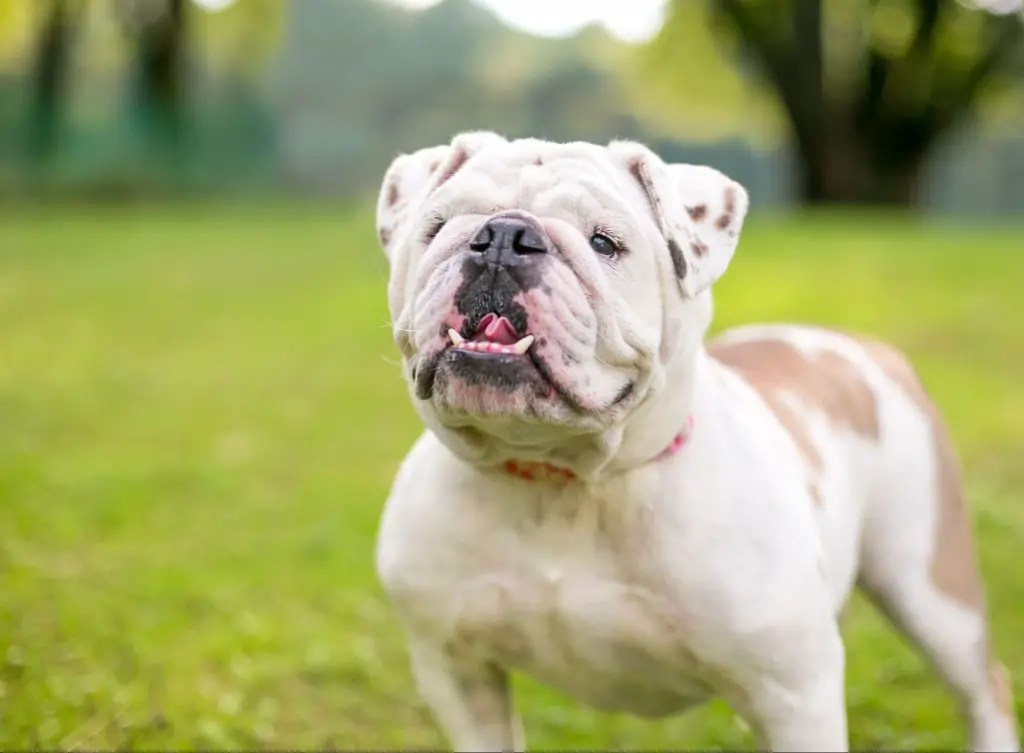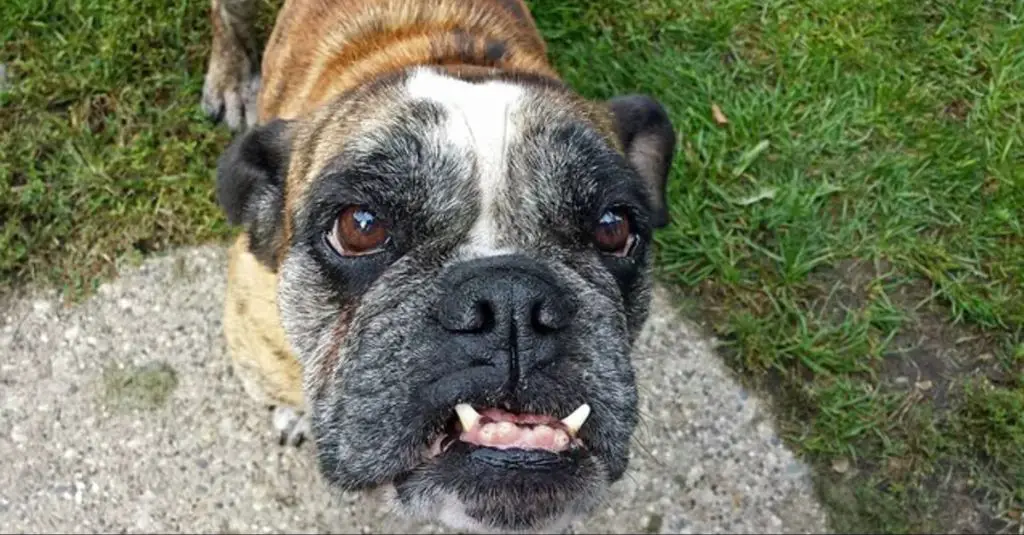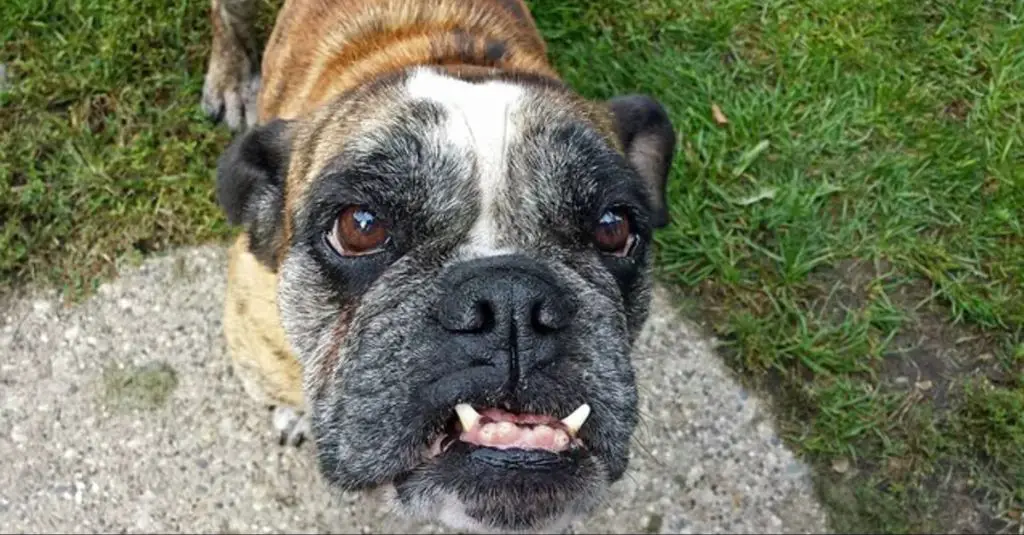Introduction
An underbite in dogs, known as a “prognathism,” occurs when the lower jaw extends beyond the upper jaw. Underbites are commonly seen in certain dog breeds like Bulldogs, Boxers, and Boston Terriers.
There has been debate around whether underbites are genetic or caused by other factors in dogs. Some claim underbites are inherited traits in breeds like Bulldogs, while others argue jaw misalignment is often due to developmental or injury-related issues. Understanding the causes of underbites is important for dogs’ health and function.
What is an underbite?
An underbite in dogs, also called an undershot bite or prognathism, is a condition where the lower jaw extends beyond the upper jaw, causing the lower teeth to protrude. The upper and lower jaws do not properly align. This is considered a skeletal malocclusion or a malformation of the jaw bones.
An underbite is the opposite of an overbite, where the upper jaw extends beyond the lower jaw. With an underbite, the lower incisors (front teeth) sit in front of the upper incisors when the dog’s mouth is closed. This can lead to trauma of the palate over time as the upper incisors rub against it.
The condition may involve just the incisors or can include the canine teeth and premolars as well. In mild cases just the lower jaw incisors protrude, while in more severe cases the entire lower jaw protrudes past the upper jaw.
Some dog breeds, like Bulldogs, Boxers and Pugs are prone to underbites due to their facial conformation and genetics. However, underbites can occur in any breed. They are most noticeable in short muzzled dogs.
According to https://blog.tryfi.com/why-do-dogs-have-underbites/, underbites in dogs are also known as:
- Class III malocclusion
- Mandibular prognathism
- Parrot mouth
- Overshot jaw
- Undershot jaw
Common dog breeds with underbites
Certain dog breeds are more prone to developing underbites due to their genetic makeup and physical characteristics. Some of the most common breeds with underbites include:

Bulldogs – Both English and French bulldogs frequently have underbites due to their short snouts and undershot jaws. Their lower jaws extend beyond the upper jaws, causing a pronounced underbite. According to one source, underbites affect around 80% of bulldogs (https://www.dogster.com/lifestyle/dogs-with-underbites).
Boxers – Boxers are brachycephalic (short-nosed) dogs that often develop underbites due to their bred-in facial structures. Their pronounced underbite is part of the breed standard.
Pugs – The short muzzles and flat faces of pugs also predispose them to underbites. Their lower jaws are longer than their upper jaws.
Boston Terriers – Boston terriers have short heads and jaws, which can result in an underbite due to the lower jaw overextending. Underbites are common in the breed.
Cavalier King Charles Spaniels – Some Cavalier King Charles spaniels develop underbites due to their small mouths and jaws.
Shih Tzus – Underbites are relatively prevalent in Shih Tzus, again due to brachycephalic facial features and breeding.
Is an underbite genetic in dogs?
There is evidence that underbites have a genetic component in certain dog breeds. According to research from PetMD, “Malocclusions can have a genetic basis that will be likely transmitted from generation to generation, and some of them will be for sure hereditary in some breeds” (1). Underbites are commonly seen in brachycephalic (short-muzzled) breeds like Bulldogs, Boxers, and Pugs. Their genetic makeup predisposes them to underbites and other alignment issues.
One study found that 70% of Boxer puppies had some form of malocclusion, indicating that underbites are part of the breed’s genetic makeup (2). While underbites may be genetic in some breeds, environmental factors like trauma or poor nutrition during development can also play a role in dogs of any breed. However, genetic underbites cannot be “fixed” and may be passed down from parents to offspring if the dogs are bred.
Other causes of underbites
While genetics play a major role, there are other potential causes of underbites in dogs:
Injury or trauma to the mouth or jaw can cause misalignment and lead to an underbite. Things like getting hit by a car or falling from a height could fracture the jaw and cause it to heal improperly.
Malnutrition, especially during development, can affect proper growth and result in skeletal abnormalities like underbites. Lack of vitamins and minerals causes bones to form improperly.
Sometimes retained baby teeth can force adult teeth to come in at the wrong angle. Baby teeth should fall out as adult teeth erupt, but occasionally they remain stuck, pushing adult teeth into abnormal positions.
Hormone imbalances can disrupt normal growth. Certain endocrine diseases like hypothyroidism or hyperadrenocorticism that affect hormone levels may be associated with the development of underbites if left untreated.

Crowded mouths with abnormally positioned teeth put pressure on the jaw, which can gradually force teeth into misalignment. This is common in small dog breeds with shortened snouts. Removing extra teeth can sometimes help.
While underbites originating from these causes are less common compared to genetic underbites, they are important to rule out as potential underlying factors with veterinary exams and treatment.
Underbite health risks
An underbite can cause several health problems for dogs if left untreated. The most common issues seen are related to misalignment of the teeth and discomfort in the jaw.
With an underbite, the lower row of teeth sits in front of the upper row. This causes the upper and lower rows to not properly align. The misaligned teeth can rub against each other abnormally leading to premature wear and dental disease. According to PetMD, underbites put extra strain on the temporomandibular joint which connects the jaw to the skull. This strain can lead to pain, arthritis, and difficulty chewing over time.
The abnormal bite also impacts how a dog’s teeth meet when chewing. This can cause trauma to the upper palate. In severe underbites, a dog’s lower teeth may damage the roof of the mouth. Irritation and discomfort in the mouth are common complaints with an underbite.
Problems with the teeth and mouth can also affect a dog’s ability to comfortably eat and swallow. Pet owners may notice drooling, gagging or regurgitation during meals. An underbite needs veterinary attention to avoid associated dental disease and injury to the mouth.
Treating underbites in dogs
There are a few options for treating underbites in dogs depending on the severity of the condition. Some of the most common corrective treatments include:
Surgery – This is the most aggressive option and involves surgically breaking and resetting the jaw to correct the alignment. It requires general anesthesia and has a long recovery time. Surgery can successfully correct underbites but is expensive and invasive (Source).
Braces – Orthodontics like braces or retainers can be customized for dogs to gradually shift the teeth into proper alignment over time. This is less invasive than surgery but requires frequent adjustments. Braces are expensive but can effectively treat underbites in dogs (Source).
Tooth extraction – Removing one or more teeth to prevent trauma and allow proper jaw closure can minimize underbite issues. This is simple and affordable but doesn’t fully correct alignment (Source).
Other options like oral appliances, tooth leveling, crowns or bonding may also be considered for improving specific underbite cases in dogs.
Living with a Dog with an Underbite
Caring for a dog with an underbite takes some extra effort but is very manageable. Here are some tips for providing the best care and preventing the underbite from worsening:

Feed your dog soft, moist food. Dry kibble can be difficult for dogs with underbites to chew and may worsen the condition. Canned food or adding water to kibble can make mealtime easier.
Avoid hard chew toys and bones. Stick to soft rubber toys that are gentle on your dog’s teeth and jaws.
Brush your dog’s teeth daily. Regular dental care helps prevent painful tartar buildup and infection (Source 1).
Schedule more frequent vet cleanings. Dogs with underbites need dental cleanings under anesthesia every 6 months rather than annually.
Monitor for signs of pain or changes. If your dog stops eating, seems irritable, or the underbite worsens, contact your vet.
Consider orthodontic correction. In severe cases, braces or surgery may help improve your dog’s bite alignment and quality of life.
With attentive care and veterinary guidance, dogs with underbites can lead happy, healthy lives.
Breeding dogs with underbites
Breeding dogs with underbites requires careful ethical consideration. While some breeds like bulldogs and boxers are prone to underbites, perpetuating the trait through breeding may lead to health issues.
According to this forum discussion, underbites are a complex genetic trait. Breeding a dog with an underbite has a high likelihood of passing the trait to offspring. Underbites often become common in certain breed lines if not selectively bred against.
Many experts advise against breeding dogs with underbites. As this PetCoach expert states, “there is a very possible chance that your pet will pass down the underbite” if bred. The offspring may develop related health problems like difficulties eating, injury risks, and alignment issues needing correction.

While some minor underbites may pose fewer risks, ethical breeders aim to better the breed and avoid propagating inherited flaws. Breeding dogs requires a commitment to puppy health through genetic screening. Ultimately, prospective owners should research breeders carefully and determine if an underbite causes concern.
Conclusion
In conclusion, underbites in dogs are a relatively common dental condition, especially among brachycephalic breeds. While underbites can be genetic, there are also several other potential causes including trauma, abnormal growth, and misalignment of the jaws and teeth.
Underbites have the potential to lead to more serious dental disease and health issues if left untreated. Mild cases may not require intervention, but severe underbites often call for correction through procedures like orthodontics or surgery. With proper treatment and care, dogs with underbites can live long, healthy, and happy lives.
For those planning to breed dogs with underbites, it is important to carefully screen for this condition and only breed dogs with mild forms. Breeding dogs with moderate or severe underbites has a higher likelihood of passing on more serious cases to the puppies. Responsible breeding practices are key to reducing the prevalence of underbites and other genetic issues in future generations.
While underbites can certainly present challenges for affected dogs and owners, they do not have to diminish one’s quality of life if addressed properly. With the right information, treatment, and care, dogs with underbites can thrive and their unique and endearing “smiles” can bring joy to many over their years.
